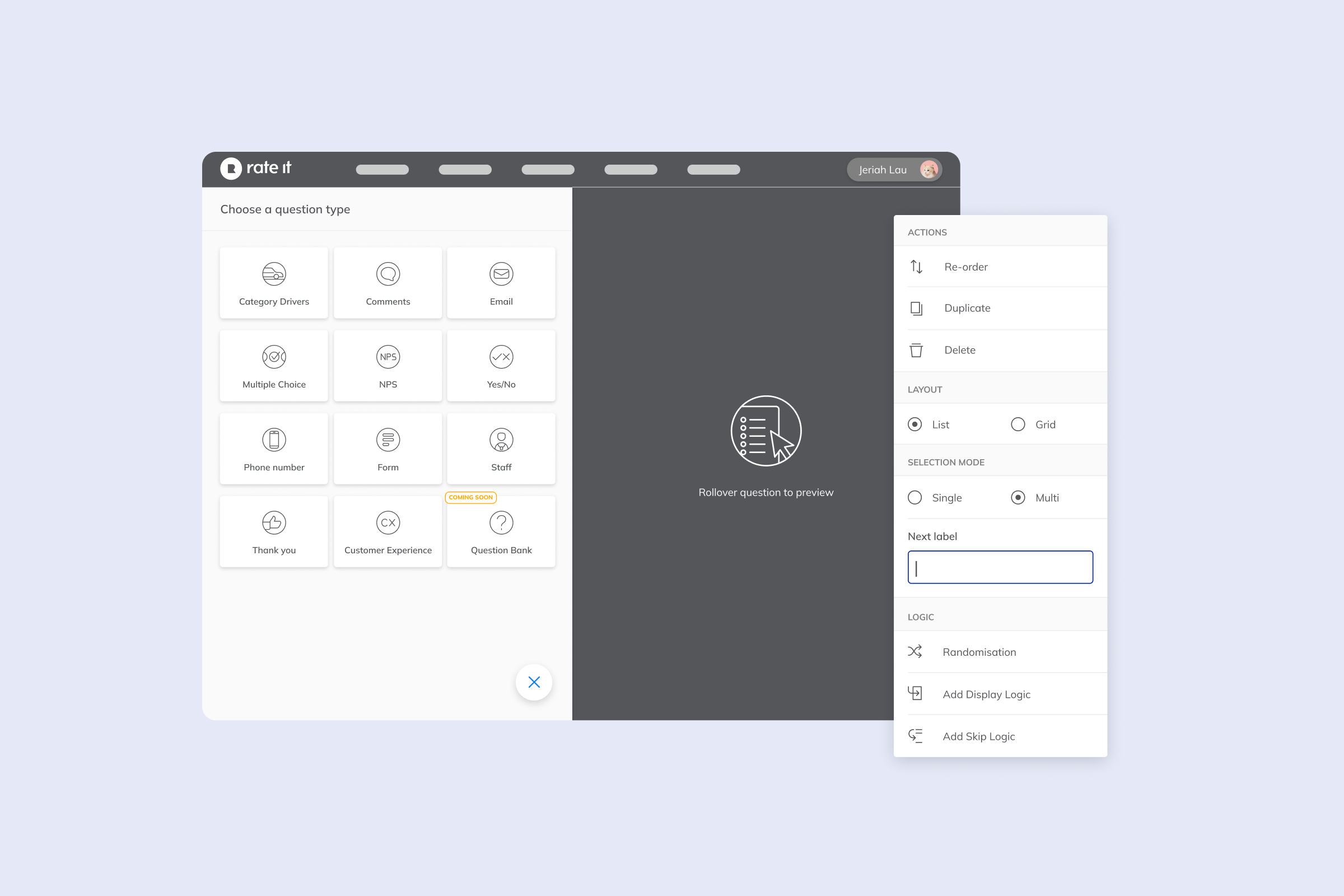RateIt Survey Builder: Providing Customer Self-Service to Improve CX Team Efficiency by Over 75%
Role
End-to-end product design
Duration
3 months
Organisation type
Start-up

Design approach
Story-map to build context & scope
By doing this exercise, I understood the breadth and key functionality of a Survey Builder. Things like “text piping”, “conditional logic” etc.
Market analysis to build context & prioritisation
I looked at the market leader, Qualtrics, and free tools such as SurveyMonkey and Google Forms. Our product scope and experience would sit somewhere in the middle. We wouldn't be a fully mature product straight away, but people were going to pay for our tool, so it had to be better than free tools.
I reviewed the tiering of features and expected pricing.
I reviewed the tiering of features and expected pricing.

Role-play creating a survey to build empathy
It’s always easier to understand a problem by doing it.
Review existing research to understand usability issues / jobs-to-be-done
Example usability issue 1
Randomisation (a feature that enables survey-to-survey rotation through a bank of questions) was only available on one question type, restricting a CX consultant's ability to cover more questions in a study.
If I’m a CX consultant, I may need to cover 15 questions in a study, but consumers are prone to answering only 3-4 questions per survey. I can use the randomisation feature to ensure I cover a credible survey sample size AND a larger set of questions, which means I can provide organisations with greater insight from the study.
Solution
Provide randomisation functionality on all 12 question types.
Randomisation (a feature that enables survey-to-survey rotation through a bank of questions) was only available on one question type, restricting a CX consultant's ability to cover more questions in a study.
If I’m a CX consultant, I may need to cover 15 questions in a study, but consumers are prone to answering only 3-4 questions per survey. I can use the randomisation feature to ensure I cover a credible survey sample size AND a larger set of questions, which means I can provide organisations with greater insight from the study.
Solution
Provide randomisation functionality on all 12 question types.

Example usability issue 2
A "previous" and "next" question needed to be manually assigned to each new question. A previous developer was concerned with the complexities of logic branching, but it created a more complex experience for the user.
Solution
Examples from the competitor landscape evidenced a new rule – use chronological ordering instead of manual ordering.
A "previous" and "next" question needed to be manually assigned to each new question. A previous developer was concerned with the complexities of logic branching, but it created a more complex experience for the user.
Solution
Examples from the competitor landscape evidenced a new rule – use chronological ordering instead of manual ordering.
Create design variations for critique
I quickly ran design concepts past CX team members at the side of their desks to understand whether a concept I proposed would help or hinder their workflow.
AI-assisted workflow

I'd use Figma AI’s First Draft function
I'd generate multiple concepts using an AI prompt to speed up how many variations I could generate within a day and subsequently test with the CX team.
I'd generate multiple concepts using an AI prompt to speed up how many variations I could generate within a day and subsequently test with the CX team.

Outcomes
To make sense of the landscape, I reviewed the existing research and mobile app. This included:
• Existing contextual inquiry and landscape review insights
• Complaints data
• Live chat data
• Stakeholder interviews with the client
Some key insights:
• A surprisingly large volume of customers use the contact centre to confirm their flights prior to travel (esp first-time flyers)
• Many customers turn up on the day of flight, unaware that they have missed a critical step prior to flight (e.g., check-in)
• Existing contextual inquiry and landscape review insights
• Complaints data
• Live chat data
• Stakeholder interviews with the client
Some key insights:
• A surprisingly large volume of customers use the contact centre to confirm their flights prior to travel (esp first-time flyers)
• Many customers turn up on the day of flight, unaware that they have missed a critical step prior to flight (e.g., check-in)
• The Jetstar mobile app was launched and has an average 4.8 star rating on the App Store.
• Positive task completion scores for key tasks provided confidence to the reduce cost to serve.
Customers with low tech confidence and little booking experience could complete high usage tasks with ease using the new solution.
• Concept-testing for new Manage My Booking experience was well-received by research participants.
• We hit all design milestones agreed to at the start of the initiative.
• Positive task completion scores for key tasks provided confidence to the reduce cost to serve.
Customers with low tech confidence and little booking experience could complete high usage tasks with ease using the new solution.
• Concept-testing for new Manage My Booking experience was well-received by research participants.
• We hit all design milestones agreed to at the start of the initiative.
• Improved CX team efficiency by over 75%
Creating and editing surveys is where the CX team spent most of their time. Since customers could self serve, the CX team's time could be spent on strategy and execution instead of manual survey building.
• Customer churn metrics were affected by COVID-19 but lead to a large pivot and the launch of a now-profitable 0-1 Aged Care product suite.
Creating and editing surveys is where the CX team spent most of their time. Since customers could self serve, the CX team's time could be spent on strategy and execution instead of manual survey building.
• Customer churn metrics were affected by COVID-19 but lead to a large pivot and the launch of a now-profitable 0-1 Aged Care product suite.
